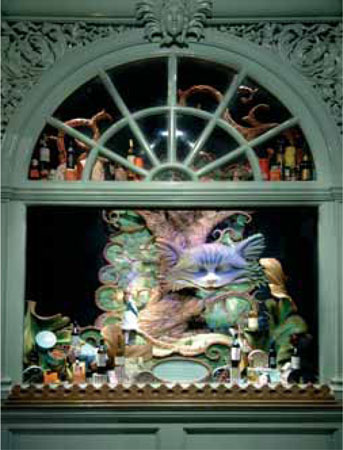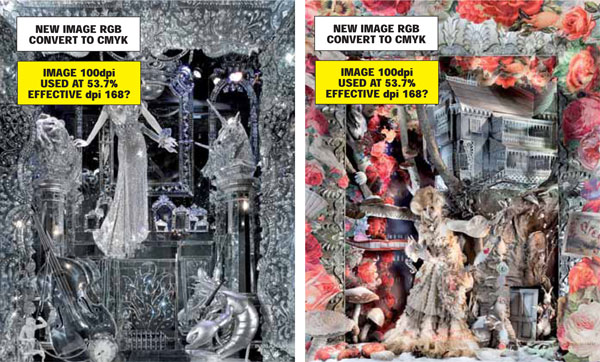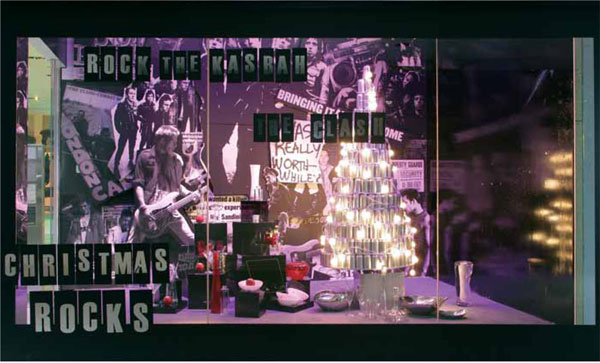Window calendar

London’s Fortnum & Mason traditionally presents elaborately themed Christmas windows. In this scheme, the front windows of the Piccadilly Street store were dominated by the tale of Alice in Wonderland. When the Christmas windows are dismantled in January, department stores usually start to plan the windows for the following Christmas. This allows time for research and design and the manufacture of props.
Large retailers will plan their window schemes well in advance using a window calendar. A well-planned window calendar will help a visual merchandiser organize window installation dates, ensure that each window has a scheme planned well in advance, and, in many cases, will help with budget allocations. In a reassuring sense, it will also help the visual merchandiser’s job run smoothly. It is highly likely that a window calendar will be amended throughout the year; promotions can run longer than anticipated, and unexpected new products often need to have windows dedicated to them. However, a tentative plan will add some structure to the process.
A window calendar is also a useful tool with which to communicate the workload for the year to others in the business. The buyers will want to ensure that the products that are to be promoted arrive in time. The sales staff will also want to make sure they have enough backup stock available in their departments.
For decades, a visual merchandising manager would plan a window calendar using seasonal events as a backbone. In Christian countries, November and December would be blocked out to promote the festive season; discounted sales would (and still do) dominate for two months in the year in winter and summer. Easter, Mother’s Day, and Valentine’s Day are just a few occasions that often have window schemes dedicated to them. It might appear thoughtful to remind the public of such events, but it can also be naive to dedicate a run of costly windows to an occasion that only lasts one day and might only generate sales of low-priced items such as greeting cards. Instead, it would be better to promote gift-giving occasions that might encourage sales.
Today, however, with the greater competition among retailers, product promotions usually supersede many of the traditional seasonal events. With this in mind, it is advisable to be aware of which new product ranges have been bought by the buying department and when they are going to appear in-store. Timing is critical for maximizing sales. It would be senseless to design a window scheme to promote new season collections if they are not present in the host department. At Selfridges, Alannah Weston prefers not to commit her windows to a year of schemes in case the fashion world dictates a new trend. “We work on only a six-month calendar because we like to keep the customer up to date with the fashion trends,” she explains. “I do not like to commit to something a year away that might not be so topical when it finally arrives. If you plan too far in advance you can miss the point. We are a fashion business, whether it is apparel or home, and we need to know what is out there in the fashion world. Attending the fashion shows is a great inspiration for me. Christmas, on the other hand, because of the vast amount of work involved, is planned a year in advance.”

This Christmas window from Harvey Nichols in London features snowflakes to produce a festive display.

Two spectacular Christmas windows from Bergdorf Goodman in New York. The intricate detail and dramatic color schemes have turned these windows into three-dimensional artworks.
In the twenty-first century, many retailers now acknowledge global traditions and beliefs. Retailers may not only attract new customers by promoting them but prove that they, too, are worldly and aware of cultural differences. A Chinese New Year window or a Diwali window may also break the traditional appearance of a company’s window displays.
An annual window calendar can start at any month of the year. Many retailers like to begin with Christmas, because those windows usually take the most planning and may need to complement the in-store seasonal decorations. Certain dates may be fixed and unable to move. It is always best to add these first to structure the calendar.
Once the proposed dates are added to the calendar, the task of designing relevant window schemes to support them can begin. To make things easier, the store windows should be numbered; the window numbers can then be set against the dates. The visual merchandiser will thus be able to check at a glance on what date windows 1 and 2 are to be re-dressed, for instance. Large stores may have numerous windows that may not all be dressed with the same window scheme. Windows may be split up to accommodate several promotions, and numbering the windows will clearly define the window allocations. A comprehensive window calendar will also show precisely when an existing window is to be stripped and the time allocated to install a new one. Remember: the less time the window is in a state of undress, the better. Window-removal dates should be considered while preparing the calendar.

Lane Crawford, Hong Kong, takes on a more contemporary and populist view with its “Christmas Rocks” display.
Structuring a window calendar
Decide how long you want your calendar to run: six months or 12? Many retailers will even use an 18-month calendar.
Decide how you wish your calendar to appear. Many visual merchandisers will use a paper chart, yet others may use a computer program that can be accessed throughout the business. An interesting calendar can be produced using images and designs to demonstrate how the window schemes appear in reality over the allocated time.
Allocate windows for major promotions first: i.e. Christmas and sales.
Add secondary promotions: i.e. Easter, Mother’s Day, Valentine’s Day.
Use the free window spaces to introduce window schemes that may be product-related: i.e. new season collections.
Discuss with the buying/marketing team if they require window space to promote new departments or special events.
Allocate budgets to each of the window schemes. Remember that Christmas windows may justifiably attract a larger slice of the budget because they are generally in for longer and because the store may wish to compete with its rivals in major shopping areas—every store wishes to be noted for outstanding window displays at this time of year. Smaller schemes that are not in for a long time should not have large budgets set against them.
Design and plan the windows well in advance. Large schemes with complex props may need a lot of attention. Prop-makers have to be briefed and their studio time booked.
Always plan the removal of existing window schemes. On most occasions this should only take a couple of hours; however, complex displays may take longer and eat into your dressing time.
Completed windows can be photographed for reference later. This is best done at night with a black screen so that you won’t get reflections. If you are a freelancer, take at least a quick snapshot for your portfolio.
